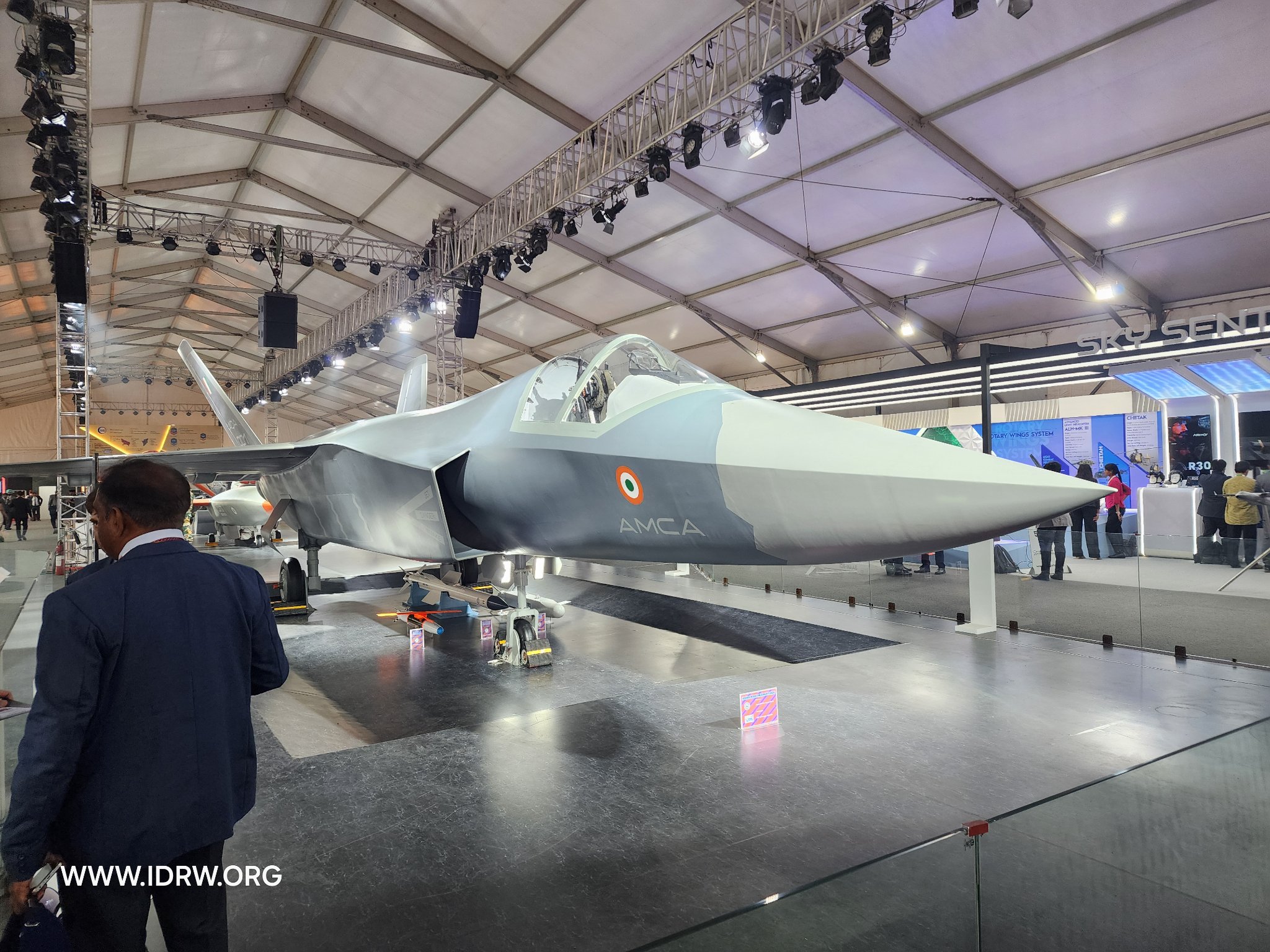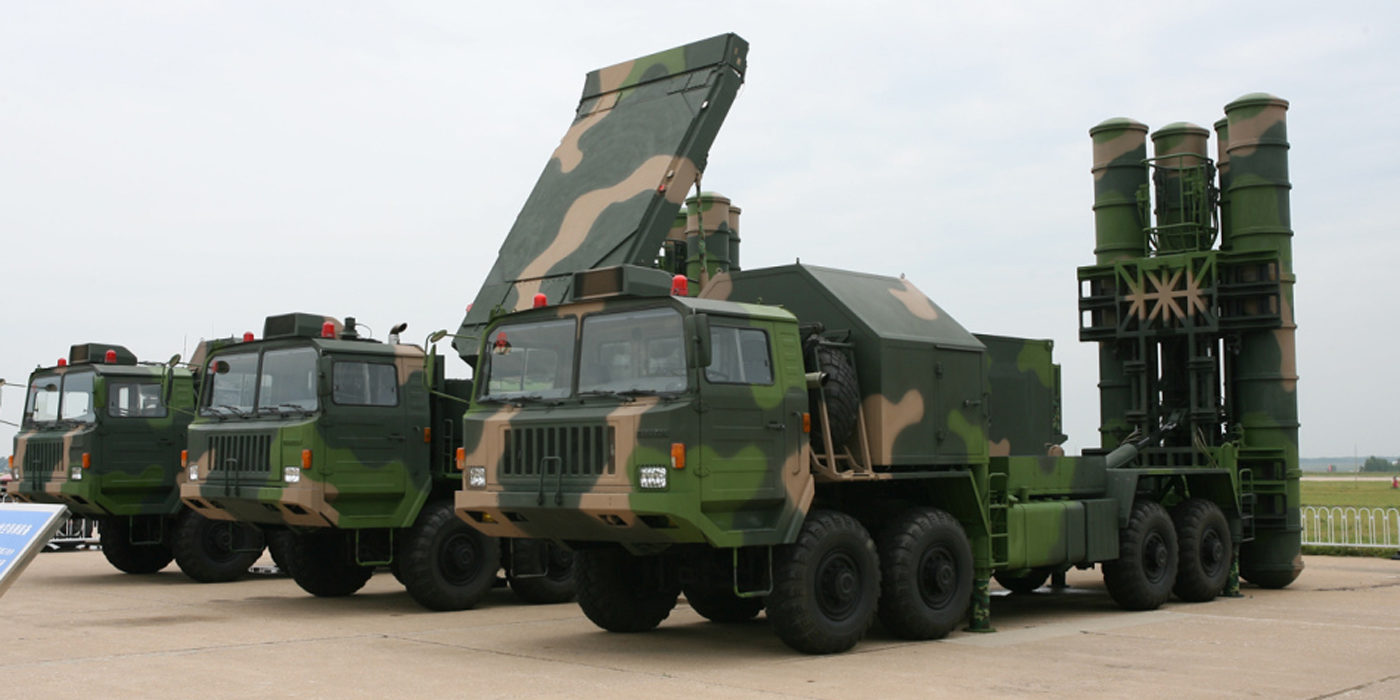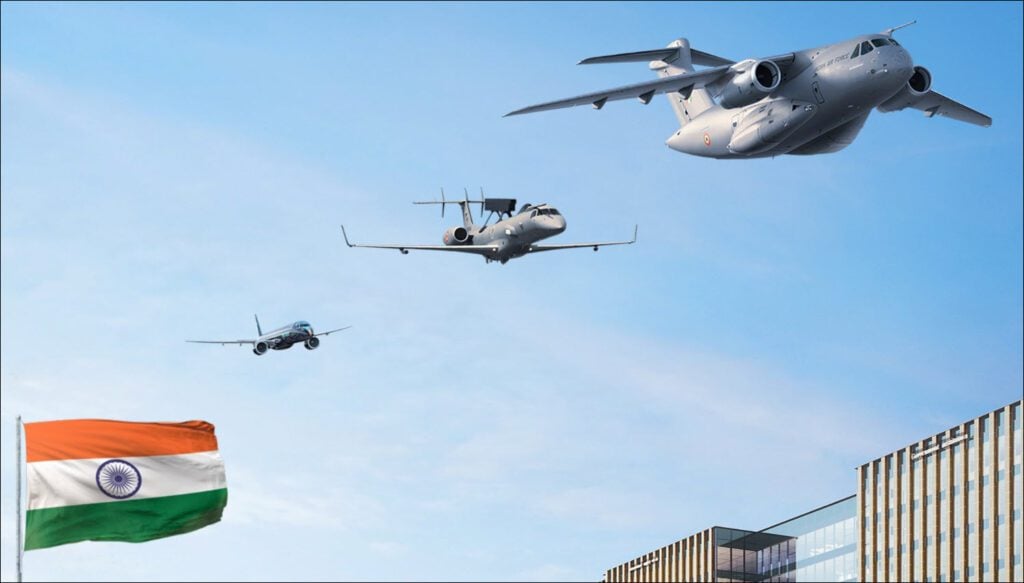SOURCE: RAUNAK KUNDE / NEWS BEAT / IDRW.ORG


On April 14, 2025, a pivotal document (Indent Ref No. AMC:2025:2026:1/C) was released, outlining the scope of work for the Advanced Medium Combat Aircraft (AMCA) programme. This ambitious initiative aims to bolster India’s defense capabilities through the development of a 5th generation fighter aircraft. The scope of work highlights four critical areas of focus, each designed to ensure the programme’s success through meticulous planning, analysis, and execution.
The first objective is to conduct a detailed study of the international landscape surrounding the development of 5th generation fighter aircraft. This involves analyzing the progress made by various countries in this domain, identifying technological trends, and understanding the challenges they face. The study will provide strategic recommendations to guide the AMCA programme’s execution, ensuring that India remains competitive on the global stage. By learning from international successes and setbacks, the AMCA programme can adopt best practices and avoid potential pitfalls.
Continue readingSOURCE: AFI


The long-speculated stealth Unmanned Combat Aerial Vehicle (UCAV) named “Ghatak,” developed by UAV Laboratory, has finally been revealed in detail at the Aircraft and Systems Testing Establishment (ASTE) of the Indian Air Force (IAF). The unveiling, which also included a demonstration for the IAF Chief, has shed light on this cutting-edge platform, as reported by the AFI. The specifications of the UCAV Ghatak highlight its potential to revolutionize combat applications for the IAF.
The Ghatak is constructed using advanced carbon fiber and Kevlar composite materials, ensuring a lightweight yet robust structure. Its dimensions include a wingspan of 1.8 meters, a length of 1.3 meters, and a height of 0.4 meters, with a delta wing configuration that enhances its aerodynamic efficiency and stealth capabilities.
Continue readingSOURCE: AFI


In the wake of the Pakistan Air Force’s (PAF) underwhelming performance with the Chinese-supplied PL-15E Beyond Visual Range Air-to-Air Missile (BVRAAM) during the recent India-Pakistan aerial conflict, Pakistani defense analysts are now shifting their focus to the PL-17, a Very Long Range Air-to-Air Missile (VLRAAM). The PL-15E, touted as a game-changer with its 145 km range, failed to score a single hit on Indian Air Force (IAF) jets despite being deployed by PAF’s JF-17 Block III and J-10CE fighters during Operation Sindoor in early May 2025. This flop has prompted a new narrative centered on the PL-17, even as significant technical and strategic hurdles cast doubt on its feasibility for PAF operations.
The PL-15E’s failure was starkly evident during the conflict, which saw the IAF achieve air dominance for the first time since 1947, as noted by former IAF Mirage-2000 pilot Sameer Joshi. Despite PAF claims of downing multiple IAF aircraft, including Rafales and Mirage 2000s, Indian authorities and independent analyses confirmed no such losses. Debris of PL-15E missiles found in Hoshiarpur, Punjab, suggested they were fired in “fire-and-forget” mode at maximum range, likely missing their targets due to inadequate guidance and the IAF’s superior electronic countermeasures.
Continue readingSOURCE: AFI


Pakistan, the world’s largest operator of Chinese weapons systems, is reevaluating its defense procurement strategy following the disappointing performance of Chinese-supplied equipment during the recent India-Pakistan conflict, Operation Sindoor, in May 2025. The conflict exposed significant shortcomings in Chinese military technology, prompting Pakistan to increasingly turn to Turkey for advanced radar and air defense systems, despite the higher costs of 50–70% compared to Chinese alternatives. This shift comes as Jordan and several African countries have also faced challenges with sub-standard Chinese-supplied unmanned aerial vehicles (UAVs) and weapons systems, highlighting broader concerns about the reliability of China’s defense exports.
Pakistan has long relied on China as its primary arms supplier, with 81% of its imported weapons over the past five years originating from Beijing, according to data from the Stockholm International Peace Research Institute (SIPRI). This dependency stems from economic constraints and favorable financing terms offered by China, which have allowed Pakistan to modernize its military despite financial instability. However, the lack of combat testing for Chinese weapons—given China’s absence from major conflicts in over four decades—has left Pakistan bearing the consequences of procuring affordable but often substandard equipment.
Continue readingSOURCE: AFI


At the prestigious CII Annual Business Summit, Dr. Samir V. Kamat, Chairman of the Defence Research and Development Organisation (DRDO), emphasized the critical need to bolster investment in research and development (R&D) to strengthen India’s defense capabilities. In his address, Dr. Kamat highlighted the current allocation of 5% of the nation’s defense budget towards R&D and shared an ambitious commitment from the Raksha Mantri to double this figure to 10% over the next five years.
Dr. Kamat underscored the pivotal role of R&D in achieving self-reliance in defense technology, aligning with the vision of Aatmanirbhar Bharat. “We need to invest more in research and development to develop cutting-edge technologies and reduce our dependence on imports,” he stated. The proposed increase in funding, he noted, would enable DRDO and its ecosystem of partners to accelerate innovation, develop indigenous defense systems, and enhance India’s strategic autonomy.
Continue readingSOURCE: PIB


In a significant boost to India’s indigenous defence manufacturing capabilities, the first centre fuselage assembly for the Light Combat Aircraft (LCA) Tejas Mk1A was handed over to Hindustan Aeronautics Limited (HAL) by M/s VEM Technologies in Hyderabad on May 30, 2025. The handover took place in the presence of Secretary (Defence Production) Shri Sanjeev Kumar and Chairman & Managing Director (CMD) of HAL, Dr. D. K. Sunil. This event marks for the first time a major sub-assembly for the LCA Tejas being manufactured by a private Indian company.
Speaking on the occasion, Secretary (Defence Production), Shri Sanjeev Kumar hailed the partnership between HAL and VEM Technologies in accelerating the production of LCA Mk 1A. He said that there is a significant growth in defence production at a rate of about 10% annually as well as in our defence exports. This would not have been possible without the support of industries and Public Sector Units like HAL. Security and sovereignty of the country are paramount and cannot be achieved without own manufacturing and supply of spare parts which could meet the requirements of the Armed Forces, he added.
Continue readingSOURCE: Embraer


Brazilian aerospace and defense major Embraer today announced a significant reinforcement of its commitment to India with the establishment of a fully owned Indian subsidiary which will have its corporate office in AeroCity, New Delhi. This strategic move underscores Embraer’s long-term vision for growth and potential collaboration with India’s rapidly evolving aerospace and defense landscape.
The establishment of a subsidiary in India aims at strengthening its interests across defense, commercial aviation, business aviation, services & support and the burgeoning urban air mobility sector. Embraer is working on growing its team in the country, building capacity to capitalize on the opportunities within the country’s ever-evolving aerospace and defense industry. This includes establishing teams across corporate functions and specialized cells focused on procurement, supply chain and engineering.
Continue readingSOURCE: REUTERS


IndiGo (INGL.NS), opens new tab will terminate its leasing agreement with Turkish Airlines by August 31 after India’s aviation regulator said on Friday it would only extend the deal for three months, a move that will push the carrier to seek alternatives.
The agreement between the two airlines has come under public criticism in India after Turkey came out in support for Pakistan during the recent conflict between the two South Asian neighbours.
Continue readingSOURCE: PTI


Union Home Minister Amit Shah on Friday lauded the BSF for its resolute response to Pakistani aggression earlier this month and said over 118 enemy posts were destroyed and damaged in retaliatory action along the Jammu frontier.
During his first visit to Jammu and Kashmir after Operation Sindoor, he said the border guarding force had dismantled the enemy’s surveillance network, dealing a significant blow that would take them years to repair.
Continue readingSOURCE: PTI


The Thane-based engineer, arrested on the charge of spying, shared sensitive information about warships and submarines to the Pakistani intelligence operative through sketches, diagrams and audio notes, and received money from various bank accounts in India and abroad in return, police said.
The 27-year-old mechanical engineer Ravindra Verma, a resident of Kalwa in neighbouring Thane, was arrested by the Anti-Terrorism Squad (ATS) of the Maharashtra police on Wednesday. According to police, he was lured into passing classified information after being honey-trapped by a Pakistani agent posing as a woman on Facebook.
Continue readingSOURCE: PTI


A trainer aircraft overturned while landing at Suktara airstrip in the district on Friday morning but its trainee woman pilot was safe, the police said. The aircraft flipped over due to a faulty landing, said a police official. The airstrip is 22 km from the Seoni district headquarters.
The trainee woman pilot who was flying the aircraft alone did not suffer any injuries, said the official.While the airstrip is maintained by the Madhya Pradesh Public Works Department, it is used by Delhi-based Red Bird Aviation Company to run a pilot training school.
Continue readingSOURCE: PTI


External Affairs Minister S Jaishankar on Friday asserted that India will never give in to nuclear blackmail, and those who “sponsor, nurture and utilize” terrorism should be made to pay a heavy price. Speaking at a convocation ceremony of foreign students of Parul University, a private varsity here, he also commented that it has become a “fashion in some quarters to openly become transactional” in international relations.
“In Pahalgam (terror attack) what we saw was an attempt to devastate the tourism economy of the Union Territory of Jammu and Kashmir as well as an evil design to bring (about) religious discord,” the minister said.
Continue readingSOURCE: PTI


The Haryana government will conduct a major statewide Civil Defence Exercise, “Operation Shield”, on May 31, across all 22 districts to enhance the state’s emergency preparedness and response capabilities.
Scheduled to begin at 5 pm, this comprehensive drill is being organised under the guidance of the Union Ministry of Home Affairs, to simulate critical incidents such as air raids, drone attacks, and other wartime scenarios in the light of current national security concerns, an official statement said here on Friday.
Continue readingSOURCE: IDRW.ORG


On May 29, 2025, the Indian Army, under the aegis of the Ministry of Defence, Government of India, issued a Request for Information (RFI) for the procurement of Manpack Counter Unmanned Aerial Systems (C-UAS) as per the Defence Acquisition Procedure-2020 (DAP-2020). This RFI aims to identify capable Original Equipment Manufacturers (OEMs), authorized vendors, and government-sponsored export agencies to supply lightweight, portable systems designed to detect, track, and neutralize hostile drones in real-time. The initiative underscores India’s commitment to enhancing battlefield survivability and operational security in response to the growing threat of unmanned aerial systems (UAS) across diverse terrains.
The Manpack C-UAS is intended to provide the Indian Army with a robust solution to counter aerial threats during tactical operations and to protect critical infrastructure. With drones becoming increasingly prevalent in modern warfare, this system is designed to detect, identify, track, and neutralize adversary drones using advanced sensors and wideband cyber electromagnetic transmitter (CEMT) capabilities. The RFI emphasizes rapid deployment, mobility, and operation in challenging environments, including high-altitude areas up to 14,500 feet, plains, deserts, and marshy terrains, ensuring versatility across India’s diverse operational landscapes.
Continue readingSOURCE: IDRW.ORG


On May 29, 2025, the Indian Army, under the Ministry of Defence, Government of India, released a Request for Information (RFI) for the procurement of Ground-Based Counter Unmanned Aerial Systems (C-UAS) as part of the Defence Acquisition Procedure-2020 (DAP-2020). This RFI seeks to identify capable Original Equipment Manufacturers (OEMs), authorized vendors, and government-sponsored export agencies to supply advanced, integrated systems designed to detect, track, and neutralize hostile drones in real-time. The initiative highlights India’s strategic focus on countering the escalating threat of unmanned aerial systems (UAS) in tactical operations and critical infrastructure defense, aligning with the nation’s push for indigenous defense capabilities.
The Ground-Based C-UAS is engineered to provide robust protection against aerial threats by detecting, classifying, and neutralizing hostile drones, enhancing battlefield survivability and operational security. With drones increasingly utilized for surveillance, reconnaissance, and attacks in modern warfare, this system integrates multiple sensors and engagement mechanisms to address diverse threat scenarios. The RFI emphasizes deployment in varied terrains, including high-altitude areas up to 14,500 feet, plains, deserts, and marshy regions, ensuring operational versatility across India’s diverse landscapes.
Continue reading